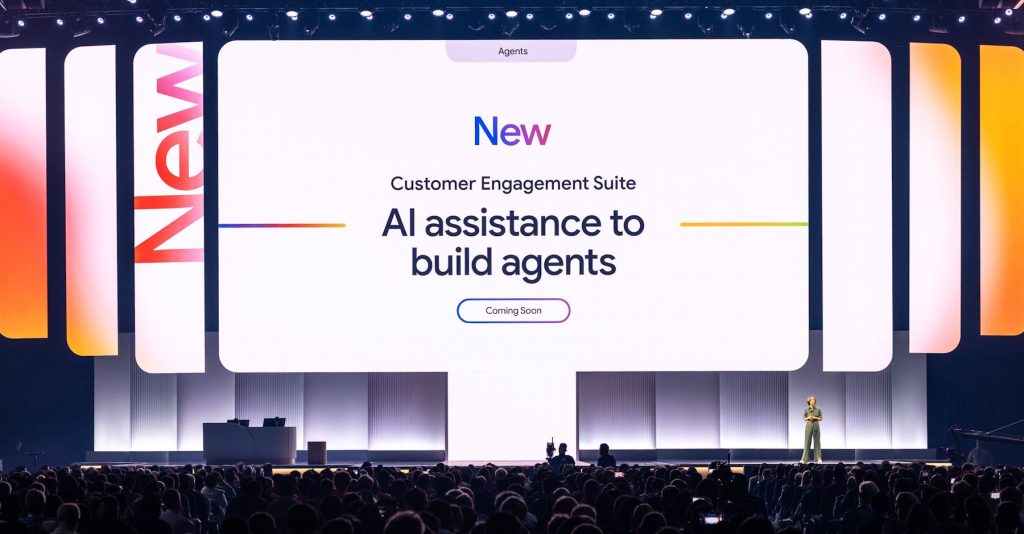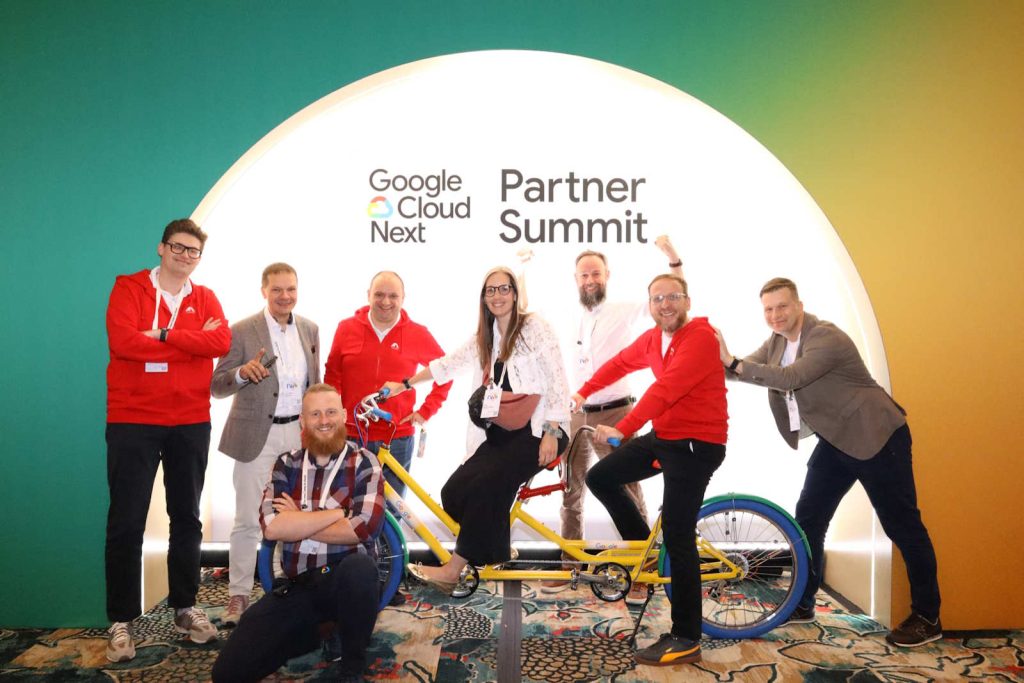This year’s Google Cloud Next ’25 conference was a powerful demonstration of Google’s commitment to the development of artificial intelligence (AI) and its integration with the entire cloud ecosystem. The event was packed with announcements regarding infrastructure, AI models, developer tools, data analysis, security, and industry solutions.
The main message of the conference was that the vision of transforming organizations with AI has become, as it was put, a ‘vital reality,’ and Google is providing the tools to enable this transformation. We at FOTC strongly believe this is true, so let’s take a look at the most important announcements.
1. Artificial Intelligence (AI) at the Forefront of Innovation
AI was the absolutely dominant theme of the conference. Google highlighted its twenty years of investment in AI and machine learning, showcasing numerous innovations.
New Foundation Models
- Gemini 2.5 Flash: Described as a “low-latency and most cost-effective thinking model,” soon available in Vertex AI, AI Studio, and the Gemini app.
- Imagen 3: Google’s “highest quality text-to-image model,” now with improved image generation and inpainting features.
- Chirp 3: An audio generation and understanding model with a new “Instant Custom Voice” feature (creating a voice from a 10s sample) and improved transcription for multiple speakers.
- Lyria: Now generally available in Google Cloud, it’s the “industry’s first enterprise-ready text-to-music model,” transforming text into 30-second clips. Google emphasized that it is “the first hyperscaler to offer this capability.”
- Veo 2: Significant improvements were presented, including first and last shot control, more camera angles, and additional inpainting and outpainting tools.
- WeatherNext AI models: Developed by Google DeepMind and Google Research, they offer fast and accurate weather forecasts, available in the Vertex AI Model Garden for customization.
Infrastructure for AI (AI Hypercomputer)
Google significantly improved its AI infrastructure, aiming to deliver “more intelligence per dollar”.
- Ironwood (7th Generation TPU): Available in 2025, Google’s latest TPU will offer “over a 10x improvement over our latest high-performance TPU” and “over 9,000 chips,” delivering a “staggering 42.5 exaflops of compute power per pod” – that’s more than 24 times faster than the world’s fastest supercomputer. It achieves 3600 times better performance than the first publicly available TPU and is 29x more energy efficient over the same period.
- Google Distributed Cloud (GDC) with Gemini and NVIDIA Blackwell: A partnership with NVIDIA (and Dell) enables running Gemini locally in “air-gapped and connected environments.” This is crucial for regulated and government industries (GDC air gap has received authorization for Secret and Top Secret missions of the US government). As NVIDIA CEO Jensen Huang said, “Google Distributed Cloud with Gemini and NVIDIA will bring state-of-the-art AI to regulated industries and countries around the world. Now, if you can’t come to the Cloud, Google Cloud will bring AI to you.”
- Pathways on Cloud: DeepMind’s distributed ML runtime environment, powering Gemini, available for the first time in Google Cloud, enabling “state-of-the-art multi-host inferencing with dynamic scaling, high performance, and optimal costs.”
- vLLM on TPU: Facilitating inference on TPU with integration with the popular vLLM library, allowing customers to use TPU “without changing the software stack.”
- NVIDIA Vera Rubin GPUs: Google Cloud will be one of the first providers to offer these next-generation GPUs, providing “up to 15 exaflops of FP4 inference performance per rack.”
- Other improvements: Cluster Director (accelerator cluster management), Titanium ML Adapter and Offload Processors enhancements (greater GPU-to-GPU bandwidth), Anywhere Cache (AI latency reduction), and Google Cloud Managed Lustre (high-performance file system) were also announced.
AI Tools and Platforms for Developers
- Vertex AI Agent Builder and Agent Development Kit (ADK): ADK is a new open-source framework facilitating the construction of multi-agent systems, supporting the Model Context Protocol and agent-to-agent communication protocol (supported by partners like LangGraph, Crew AI). Google Agent Space allows employees to utilize AI agents within an organization.
- GKE Inference Gateway and Quickstart: Intelligent scaling and load balancing for AI inference tasks in GKE, reducing costs and latency. Quickstart simplifies deployment.
- Code Assist Agents: New agents supporting code modernization and the entire software lifecycle, with integrations from partner platforms (Atlassian, Sentry).
- Gemini in Workspace: New features: “Help me analyze” in Sheets, “Audio overviews” in Documents, and “Google Workspace flows” for automation.
- Vertex AI Model Garden: Access to over 200 models (Google, partners, open-source) and new dashboards for monitoring.
- BigQuery DataFrames with AI Code Assist (Preview): Generating and explaining SQL/Python code using natural language.
- Code Interpreter for Conversational Analytics (Preview): Enables business users to forecast and detect anomalies in BigQuery DataFrames using natural language.

2. Improved Cloud Infrastructure and Services
Beyond AI, Google Cloud has strengthened its core services.
Network and Computing
- Cloud Wide Area Network (WAN): Google’s global, private network available for enterprises, offering “over 40% faster performance” and reducing Total Cost of Ownership (TCO) “by up to 40%.” It is already being used by companies like Citadel Securities and Nestle.
- New VMs: H4D (based on 5th gen. AMD EPYC for HPC), M4 (certified for SAP HANA, up to 65% better price-performance ratio), Cloud SQL, and AlloyDB available on C4A instances (based on Google Axion processors).
Data Storage and Databases
- Storage: Z3 family with new Titanium SSDs, new bare-metal instances (up to 72TB SSD), BigQuery Tables for Apache Iceberg (Preview), Storage Intelligence (object metadata analysis using LLM).
- Databases: Oracle Base Database Service and Exadata X11M (GA), Database Migration Service (DMS) now supports SQL Server to PostgreSQL migration, Database Center (GA) for database fleet management, Spanner Vector Search (GA) and graph visualization.
Network Security
- DNS Armor (Preview): Detection of data exfiltration attacks via DNS.
- Cloud Armor and Cloud NGFW improvements: New hierarchical policies, tags, L7 domain filtering for more granular control.
Containers and Hybrid Cloud
- GKE: Improvements for AI (see above).
- Hybrid/Multi-Cloud: Nutanix Cloud Clusters (NC2) on Google Cloud (Public Preview), Google Cloud VMware Engine extension (18 new node types).
3. Strengthening the Position of Developers
The conference strongly emphasized support for developers.
- AI Tools: ADK, Vertex AI Agent Engine, Model Garden (see above).
- IDE Integrations: Gemini was showcased in popular IDEs (e.g., Windsurf) for agent-based coding.
- Cloud Investigations: Tools facilitating debugging (Gemini suggesting code fixes).
- Looker Reports Improvements: Intuitive drag-and-drop interface, real-time collaboration.
- Acquisition of Spectacles.dev: Automation of SQL and LookML change testing.
4. Security and Compliance
Key points:
- Google Distributed Cloud (GDC) for sensitive workloads, with US gov (Secret/Top Secret) authorization and Gemini availability.
- Support for NVIDIA Confidential Computing in GDC.
- Tools like DNS Armor, improved Cloud Armor, and Cloud NGFW.
Summary
Google Cloud Next ’25 was a clear signal of Google’s leadership in the field of AI and its commitment to delivering a comprehensive, innovative cloud platform. Facilitating access to advanced AI models and infrastructure, combined with enhanced developer tools and a strong partner ecosystem, positions Google Cloud as a key partner for organizations seeking to transform their business using AI and the cloud.
And we at FOTC are very pleased with this, because as one of Google’s main partners, also in the field of AI and Data, we can offer our clients support in this area. We invite you to contact us today!
All those interested in a more detailed summary are invited to visit the Google page: 229 things we announced at Google Cloud Next ’25 – a recap.
Photo credit: Google Cloud Blog

